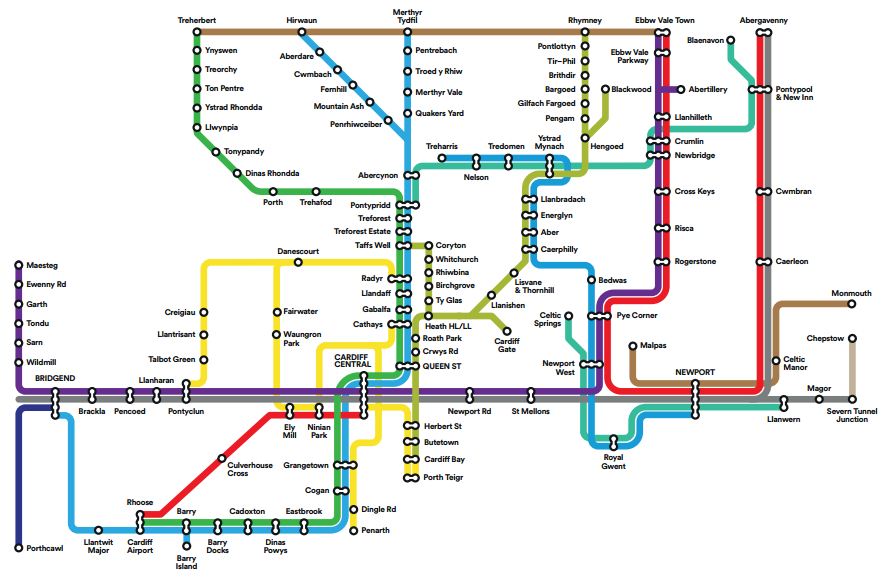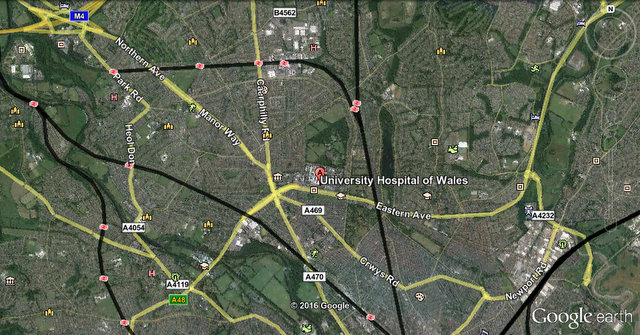On the Right Tracks (mainly)
This week's edition of the Cynon Valley Leader carries two interesting transport-related stories.
The first is good news. The upgrade of the Severn Tunnel to support electric trains is due to be completed on time – next weekend, in fact. There's still a lot of work to be done until the first Twentieth Century (not a typo) trains actually glide into Cardiff Central, of course, but it's a step in the right direction.
The second story concerns the South Wales Metro scheme, which I've written about extensively already. According to a piece by Sion Barry (originally published last week, but only now filtering through to the 'locals'), four companies have been shortlisted for the bidding process to build the infrastructure.
As usual, the story is accompanied by the map of the proposed network.

However, it's occurred to me recently that there seems to be one massive, glaring omission from the whole scheme.
The place I've got in mind isn't a tourist attraction; it probably doesn't feature on many 'must-see' lists. It's hardly likely to pull in the crowds who flock to Cardiff to work, to study, to shop; to visit the cinema, watch a play or take in a show; to enjoy the Six Nations and the Xmas market; to explore the castle and its grounds, the museum, the Senedd, the Wales Millennium Centre, or even the Doctor Who exhibition.
On the other hand, in an average day thousands of members of staff and huge numbers of the public pour into this place from right across South Wales and even further afield. I dare say not many of the latter group make this visit by choice, but that's not the point.
I'm talking about the University Hospital of Wales (UHW).
I've been there several times in the past few months – not because I wanted to, but because I had to. Each time it's been an 'interesting' experience, to say the least.
The first time, it was approaching midnight on the Sunday of the Whitsun weekend. I was sitting in the passenger seat of an ambulance, chatting to a paramedic, while doing 'blues and twos' well in excess of the national speed limit down the A470. I'd manage to persuade them to take me along for the ride while the patient was being transferred from our 'local' hospital. After all, I had a far better chance of getting back from Cardiff on a bank holiday than I did of getting back from two miles outside Merthyr Tydfil.
At about 7 a.m., when it appeared that I wouldn't get any information about the outcome of an emergency neurosurgical operation, I decided to seek out some breakfast. Obviously, the hospital was running a skeleton staff. The cafeteria was closed. The only hot drinks machine I found was out of order. I decided to cut my losses and head into town instead.
There was little, if any, information available about bus services into the city centre. As I'd only been there a couple of times previously – usually in a work colleague's car for the Freshers' Fairs – I had only a sketchy memory of the way back. After half an hour spent wandering around interchangeable residential streets and trying to make sense of the rudimentary map displayed in a bus stop, I eventually arrived at the Heath pub.
I knew my way from there to Gladstone Primary School; thence I was able to get to the Crwys, cut across to the Woodville, and finally stroll down to Cathays station. It's an unorthodox orienteering technique – a pub crawl without actually buying a drink – but it's served me well for years.
My second visit was by public transport, a few days later. With an eye to saving money, I bought a return rail ticket from Aberdare to Heath High Level. There was a good reason for this: UHW is popularly known as 'the Heath Hospital' – so, logically, I'd assumed that the two places would be fairly close together.
Big mistake!
On exiting the station, I'd expected to find a handy sign pointing people directly to UHW. There was nothing. I followed my nose vaguely southwards. I wasn't too encouraged when a car pulled up about two minutes after I'd left the station, and the driver asked me if I could point him to the hospital.
I thought, 'Stone me, if he can't find it and he's motoring around, what chance do I have?' So I carried on walking …
Roath Park was absolutely glorious. I've never been there before, and I'm going to pay a return visit next summer – by choice. At the southern end of the park, I was expecting to find signs pointing me to the hospital. Once again, there was nothing.
I wandered for ages before I found a lane running parallel to the A48. I then spent at least fifteen minutes trying to cross the A48 and find the entrance road to the hospital itself. In fact, the only sign for UHW I found after leaving Heath High Level was at the junction of Allensbank Road and King George V Drive. By the time you're at that point, it's pretty fucking obvious where the hospital is. Talking about shutting the stable door …
Things didn't improve once I was inside. There's a little schematic in the foyer that might have been drawn by a six-year-old child as a plan for a very simple Lego house. There's also a huge scale model of the entire Heath Park complex, which is great to look at but serves as much practical use as an ashtray on a motorbike.
I did suggest (in an unpublished letter to the South Wales Echo) that the Cardiff & Vale University Health Board could run a competition, open to students with a flair for graphic design, to come up with something a bit more user-friendly. Most importantly, it could be adapted to include the vital words YOU ARE HERE wherever it's displayed: at every lift and stairwell; at every intersection of identical corridors; at the entrance to every department, ward, specialist unit, outpatients' clinic, relatives' room and waiting area – not to mention at every weird exit that takes you outside the building and forces you to circumnavigate the entire site in order to get back inside.
So I'm making that suggestion again here. I know it's a bit off-topic, but since this whole blog is about getting from A to B in Wales, I think it's worth including.
Instead of heading back to the station, I travelled into town by bus. I had as much chance of finding Heath High Level on foot as I did of winning the previous night's Lottery draw.
A few days later I travelled down again, armed with my iff card for Cardiff Bus (see the previous entry). The journey from the city centre took just over thirty minutes. That was on a Saturday afternoon, when the traffic in the suburbs is fairly light.
I did the same journey two weeks ago, on a Thursday afternoon, and it took over forty minutes. The bus had to plough through the suburban streets at a time when schools are finishing for the day, with all the additional traffic that entails. I reached the reception desk with just a few minutes to spare, after leaving Aberdare two hours earlier.
Have a look at this image I grabbed from Google Earth earlier, with UHW at the centre. The heavy black lines which almost enclose it are the Valley Lines rail routes. The red British Rail logos show the stations.

As you can see, neither Heath High Level (on the Rhymney Valley line, running north-south at the centre) nor Heath Low Level (on the Coryton spur, running east-west near the top) are anywhere near the hospital. Even the proposed new station at Roath Park (the dark green patch roughly parallel to the Rhymney line) would still be a fairly long way from UHW.
Cathays station, the nearest stop on the Taff Vale branch, is towards the bottom of the map. The only other stop on the line – leading to Pontypridd and then splitting to serve the Cynon, Merthyr and Rhondda valleys – remotely close to UHW is Llandaff North, about three miles to the west.
So, here's my radical proposal. Instead of having a little stop at Roath Park on the Rhymney Valley branch, as outlined in the South Wales Metro plan, why don't we think a bit more holistically? Wouldn't it make sense to physically connect the two main branches in this vicinity? You could run the new line from a point on the Rhymney branch, tie it into the Taff branch somewhere south of Llandaff North, and build a dedicated station within the grounds of the hospital itself. This would allow people to travel directly across to UHW without having to go into Queen Street (a notorious bottleneck) and change there.
We could even think really big and build a double connection, with lines running into the hospital from both Llandaff North and Cathays (on the Taff branch), and from both Heath and the proposed station serving Crwys Road/Albany Road (on the Rhymney branch), putting UHW at the heart of an X-shaped section of new infrastructure. Theoretically, all we'd need are two shuttle services, going from one corner of the X to the other. They could operate from early in the morning to late at night, allowing staff, patients and visitors to travel straight to the hospital. Not only would this new section of railway serve the hospital, though. Think about the wider implications for a few minutes.
Passengers from the Rhymney Valley travelling to Cardiff University could catch a southbound shuttle service from Heath High Level to Cathays via the new line through UHW. People wanting to get to the hospital from the Taff Vale side would change at Llandaff North and go straight in from there, before the service terminated at Crwys Road further south.
Before people start objecting that the land isn't available, I'd refer them to the Docklands Light Railway in London, which runs on elevated lines for much of its length. After all, if Cardiff wants to continue to reinvent itself as a Twenty-First Century city, shouldn't it have a modern public transport system to go along with all the new buildings?
As I've said many times before, I'm not an academic, an architect, a town planner, a civil engineer, an economist, a social scientist, or a politician. I'm just an ordinary guy who travels around a lot by public transport, sees the problems wherever they occur, and makes bizarre and ambitious suggestions about ways to alleviate them. But, speaking from my vantage point as an enthusiastic amateur, leaving the massive complex at Heath Park out of any plans to upgrade the capital's transport infrastructure would be short-sighted at best – and downright bloody criminal negligence at worst.
Comments
Post a Comment